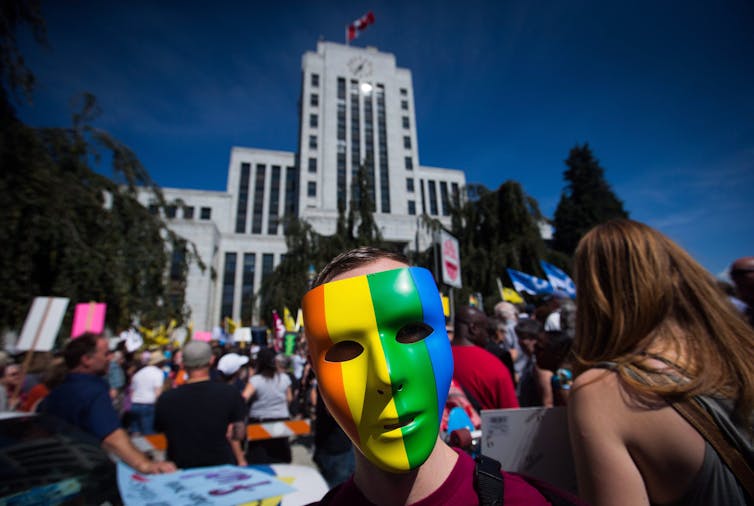Approximately 4,000 people gathered at Vancouver’s City Hall on Aug. 19 to protest an anti-immigration and anti-Muslim white nationalist rally. They far out-numbered the white nationalist demonstrators. Later, one counter-protester interviewed by CBC-TV news said: “I’ve never seen a racist.”
Did that counter-protester come to the rally hoping to see a racist? What do racists look like, anyway? Are they easily identifiable? Perhaps he was imagining a stereotypical neo-Nazi?
Although his statement was naive and problematic, it actually reflects common misunderstandings of white supremacy and racism in Canada.
It also reflects the mythical Canadian narrative of inclusivity and diversity. Canadians widely believe their country to be a peaceful, multicultural country without racism.
Yet human rights activists and critical race scholars provide evidence that inequity is woven into the fabric of Canadian institutions and normalized in everyday practices.
The absence of racism and racists is one of Canada’s “fable-like” racial stories. In Racism Without Racists, scholar Eduardo Bonilla-Silva says we tell and retell ourselves the same moral story.
The majority of racism “remains hidden beneath a veneer of normality,” says sociologist David Gillborn, “and it is only the more crude and obvious forms of racism that are seen as problematic by most people.”
Institutions of higher education are especially prone to reproducing inequalities beneath a “facade of meritocracy and colour blindness.”
As a Black feminist and critical researcher of race and education at UBC, it is not uncommon to encounter students and colleagues who deny not only institutional racism in Canada but also the ways in which we are all implicated.
This matrix of domination permeates our universities, schools, communities, religious institutions and even our families. That is, intersecting dimensions such as race, class, gender, sexuality, disability and religion affect us all but they can be especially powerful in Canadian institutions.
Suits and ties, a new face of white nationalism
In a recent magazine article, Toronto Black Lives Matter co-founder Janaya Khan credits the lack of critical engagement with race as contributing to the success of white nationalism in Canada.
She says Canadians “have a deep investment in seeing themselves as more enlightened than their counterparts to the south, as if racism and bigotry suddenly stop at the U.S./Canada border.”
Human rights activist and author Leonard Zeskind recently explained the new face of the movement: “It is not one of an angry Klansman in a robe — it’s a young, educated, well-spoken white American.” He describes white nationalists as “smart, mostly middle class and a democratic slice of America.”
To claim to have never seen a racist does not preclude the ubiquity of racism or white supremacy. Today, white supremacists are not white sheet, brown shirt types. But as Zeskind says, “they’re black suits, brown suits, business people.”
Engage critically with race
Those who do not experience racism may be unaware of how it functions in Canada — perniciously and insidiously. For example, The Black Experience Project, a six-year study released this July found Blacks, when compared to non-Blacks nationally, “earn lower incomes, experience higher rates of unemployment, and higher rates of incarceration. They also suffer poorer health outcomes, have more housing difficulties and are more likely to be victims of violence.”
In Vancouver, we like to tout our inclusivity and diversity without acknowledging racism or the experiences of Indigenous and racialized people.

I find many residents not only ignorant of the historical Black British Columbian past but also of Black people currently living in British Columbia.
If you’re interested, a few important contributors to British Columbia Black history are: Alice Walker biographer Evelyn C. White, journalist and college professor Crawford Killan, and Wayde Compton, a Vancouver activist and acclaimed writer who is also the program director of creative writing in continuing studies at Simon Fraser University.
Challenge ‘normal’
How often do those of us who work at universities question who receives awards or who gets admitted to programs? Do we question the the lack of representation of racialized and Indigenous tenure-track and tenured faculty. Do we challenge the predominant whiteness of senior leadership teams and Canada Research Chairs? These examples illustrate how white supremacy surreptitiously and successfully performs its work.
In a recent essay, education researcher Michelle Stack gives practical examples of how white educators can work against racism.
All of us must do anti-racist and anti-oppressive work.
If only Indigenous and racialized instructors are teaching about colonialism, systemic racism and white supremacy, the burden remains greater for these marginalized faculty. The same applies to only women, or only LGBTQ instructors teaching about feminism or sexuality, or only people in disability studies teaching about disability. All of us need to be involved.
Moreover, when these subjects are taught in disparate ways in disparate departments, students cannot understand the intersections of these social dimensions.
Although we cannot be experts in all areas, we need to give students a framework to analyze the world in which they live — and will hopefully work to change.
With all of us, including senior leadership, persistently contributing to eradicating these pernicious practices and developing transformative strategies, conversations about race and equity can become part of the everyday dialogues in classrooms, departments, selection committees and wherever important decisions are made.
The white male protester who said he’d never seen a racist has most likely lived with the white privilege of never having to witness or to recognize incidents of racism that people of colour frequently encounter.
He likely would not have confronted the ways that systemic racism pervades all of our lives and is routinized in everyday Canadian life.
Whether the racism is crude and obvious — or hidden in normal routines like a sly fox — he simply may not have recognized it.
Author: Annette Henry: Professor, David Lam Chair in Multicultural Education, Faculty of Education, cross-appointed to the Social Justice Institute, Faculty of Arts., University of British Columbia
Credit link: https://theconversation.com/dear-white-people-wake-up-canada-is-racist-83124<img src="https://counter.theconversation.com/content/83124/count.gif?distributor=republish-lightbox-advanced" alt="The Conversation" width="1" height="1" />


